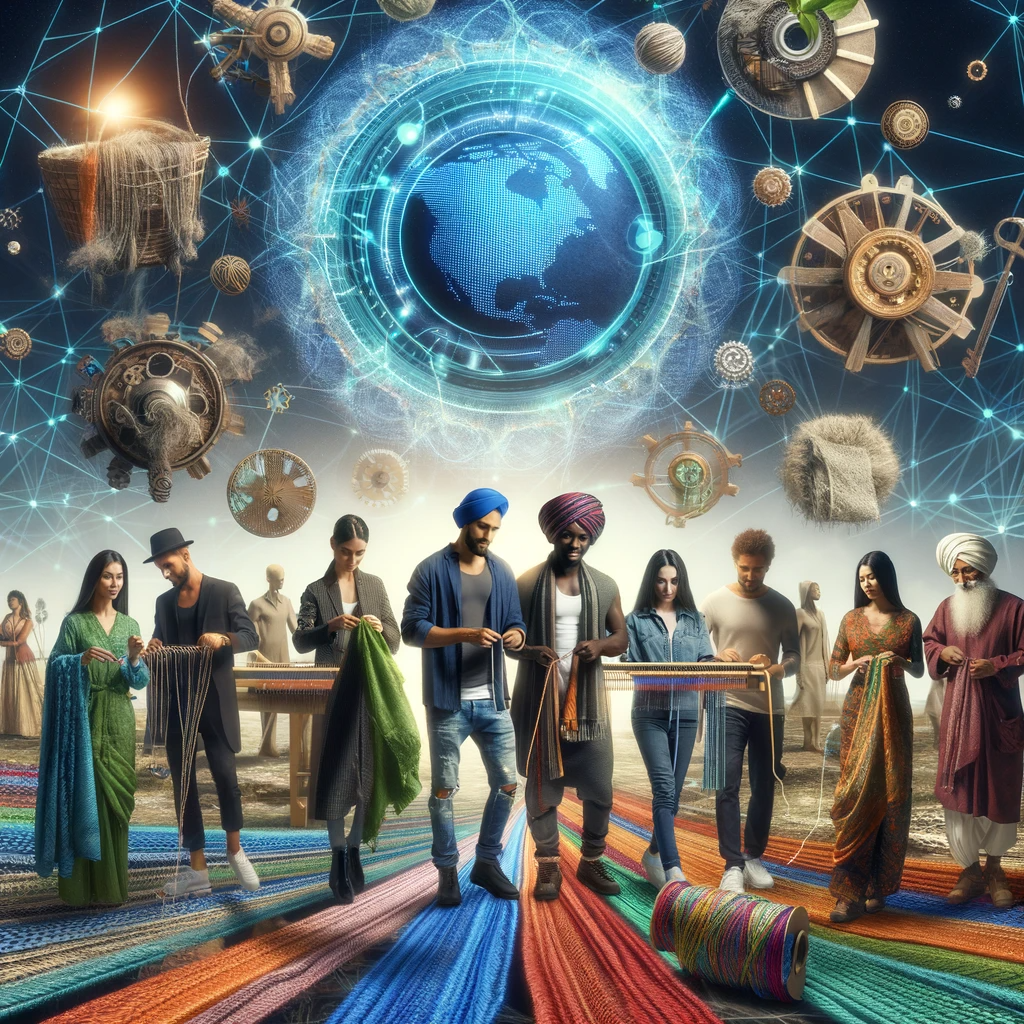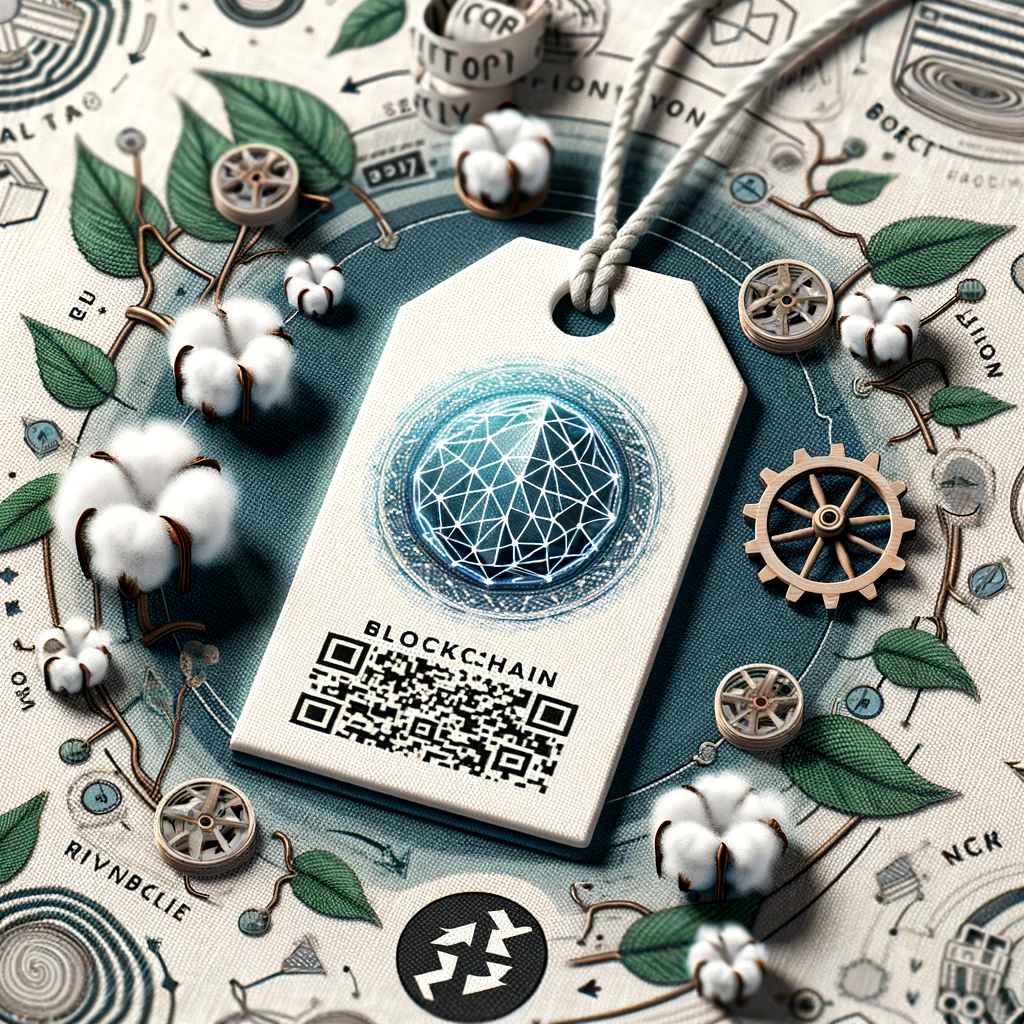BY CHRIS JONES | JANUARY 10, 2024 | 7 MINUTE READ
The fashion industry, a dazzling behemoth shimmering with trendsetting threads, casts a long shadow on our planet. From water-guzzling cotton fields to overflowing landfills, its traditional "take-make-dispose" model screams unsustainability. But a revolution is stirring at the loom, woven with the transformative threads of blockchain technology and the vision of Circular Fashion 2.0. This isn't just a whisper of change; it's a bold symphony where transparency, traceability, and innovation harmonise to create a vibrant, sustainable future for fashion.
Imagine a garment whispering its origin story – the sun-kissed cotton it's woven from, the fair hands stitching it together, the journey it took from farm to fabric, factory to store. This isn't science fiction; it's the power of blockchain, a distributed digital ledger meticulously tracking every step a garment takes, from raw material extraction to its final resting place. Each block, encrypted and unalterable, holds a piece of the garment's story, empowering consumers with informed choices and brands with unparalleled accountability. This radical transparency, the cornerstone of Circular Fashion 2.0, is more than just feel-good fluff. It builds trust, paving the way for premium pricing for brands committed to ethical practices. It ignites consumer engagement as customers connect with the values and stories behind their clothes. And it fuels operational efficiency, allowing brands to pinpoint inefficiencies, streamline logistics, and drive down costs.
But transparency is just the first stitch in this vibrant tapestry. Traceability, the invisible thread tying it all together, takes centre stage. No longer will clothes flit through an opaque supply chain, nameless and faceless. Blockchain threads a trail of breadcrumbs, allowing us to track every movement of materials and garments in real time. Imagine this meticulous tracking not just as a sustainability boon but as a profitability game-changer. Imagine reducing inventory waste by predicting demand with pinpoint accuracy. Imagine optimising transportation routes and logistics based on real-time garment location. Imagine minimising fraud and counterfeiting through secure chain-of-custody data. The possibilities for cost reduction and revenue optimisation are vast, making Circular Fashion 2.0 not just an ethical imperative but a strategically sound business decision.

Digital transformation of the fashion industry: powered by DALL·E
2024 could be the year this symphony reaches its crescendo. With technological advancements turbocharging digital transformation, capturing accurate data and streamlining processes like never before becomes reality. We're talking IoT sensors embedded in garments, smart contracts automating transactions, and AI-powered analytics extracting actionable insights from the vast data ocean. This synergy of technologies will power a wave of innovation, from intelligent garment factories to hyper-personalized customer experiences.
But amidst the tech symphony, let's not forget the maestro – Generative AI. Imagine using the rich data tapestry woven by blockchain and other technologies to fuel AI models that design sustainable garments, predict future trends, and even personalize clothing production based on individual preferences. This isn't science fiction; it's the cutting edge of Circular Fashion 2.0, and it holds the potential to revolutionise the entire industry.
Circular Fashion 2.0: Beyond Patchwork Recycling
While crucial, Circular Fashion 1.0 (emerging around 2017-2018) was merely a stepping stone, focusing primarily on patching the fabric with recycled post-consumer garments. Circular Fashion 2.0 paints a holistic canvas, weaving a future where sustainability isn't an afterthought but the very thread of the industry.
This transformative vision goes beyond patching the fabric with recycled scraps:
Design for Disassembly: Garments are no longer disposable entities but thoughtfully designed for easy disassembly. Think modular components instead of stitched monoliths. This facilitates material recovery and reuse, allowing garments to experience multiple curtain calls on the stage of style.
Circular Material Sourcing: Virgin resources fade into the background as sustainable and recycled materials take centre stage. Ocean-bound plastics reborn as swimwear, discarded fishing nets transformed into sleek jackets – Circular Fashion 2.0 embraces innovation and imagination to close the loop on resource consumption.
Extended Producer Responsibility: The spotlight shifts from just production to a commitment that extends throughout the garment's lifecycle. Brands become stewards, not just designers, taking ownership of collection, sorting, and recycling. This shared responsibility ensures garments receive a graceful exit after their time on the catwalk, not an unceremonious toss into the landfill shadows.

The collaborative tapestry of the fashion supply chain: powered by DALL·E
Navigating the Data Ocean: Collaboration and Blockchain Trust
While Circular Fashion 2.0 requires a collective effort to gather the vast ocean of data spanning the supply chain, ensuring its legitimacy and trustworthiness is crucial. This is where blockchain, the tamper-proof digital ledger, steps in as a revolutionary game-changer.
Imagine an intricate network of partners seamlessly sharing data – farmers recording resources vs. cotton yields, manufacturers documenting production processes, and recyclers tracking garment lifecycles. This collaborative effort generates an immense repository of information crucial for driving informed decisions and transparent practices. However, without trust in the data's accuracy and reliability, the entire system crumbles.
Enter blockchain, the ultimate trust architect. Every piece of data collected is meticulously encrypted and added to a chain of interconnected blocks. Each block references the previous one, creating an unalterable timeline of events. Any attempt to tamper with the data would disrupt the chain, exposing the discrepancy and ensuring its validity. This unparalleled security builds trust not just among collaborating partners, but also with consumers and governments alike.
While collaboration is essential for gathering the enormous volumes of data of Circular Fashion 2.0, it's blockchain's unwavering data integrity that builds trust and fuels revolutionary change.
The Transparency Game Changer
But just like a flawless orchestra needs a skilled conductor, Circular Fashion 2.0 relies on blockchain within a connected fashion technology eco-system to harmonise its notes and orchestrate its transformative dance.
Here's how this innovative technology plays its critical role:
Empowering Consumers with Informed Choices: Scan a garment's tag, and its full story unfolds – the origin of materials, production processes, certifications, and even past ownership. This newfound transparency builds trust and empowers conscious buying decisions, allowing consumers to support brands aligned with their values. No more greenwashing in the shadows; blockchain shines a light on every corner of the supply chain, minimising the risk of unknowingly complicit consumers.
Holding Brands Accountable: With each step etched onto the blockchain, brands and manufacturers become accountable for their environmental and social impact throughout the entire supply chain. It's no longer a game of smoke and mirrors; true responsibility takes centre stage, driving positive change from farm to shelf.
Authenticating Recycled Content: No more greenwashed claims of recycled fibres. Blockchain verifies the origin and composition of materials, ensuring recycled content isn't just a costume but a genuine commitment to circularity. Gone are the days of greenwashing, with blockchain ensuring transparency and consumer trust.

The trust architect for traceability: powered by DALL·E
Optimising Reverse Logistics and Fostering a Vibrant Pre-Loved Community
Blockchain doesn't just shine a light; it streamlines the journey. Imagine worn-out jeans waltzing to the right recycling facility instead of getting lost in a landfill tango.
Optimising Reverse Logistics: Tracking garments in real-time becomes child's play with blockchain. This precise choreography leads to efficient collection, sorting, and recycling processes, maximising resource recovery and minimising waste.
Elevating Peer-to-Peer Marketplaces: Second-hand clothes shed their stigma and embrace the blockchain stage. Secure platforms for peer-to-peer trading flourish, extending garment lifespans and nurturing a vibrant pre-loved community. This promotes circularity and creates new avenues for conscious consumers and creative entrepreneurs.

Streamlining the entire fashion lifecycle: powered by DALL·E
Investing in the Future
The journey towards Circular Fashion 2.0 is a collaborative waltz, not a solo sprint. Partnering with trusted industry leaders like JBSO Group can empower your brand to step onto the dance floor. From implementing cutting-edge blockchain solutions to optimising supply chains and leveraging AI-powered insights, JBSO Group supports your brand in every step of this transformative journey.
Fashion Tech Solutions Weaving the Future of Circularity
Beyond JBSO Group, a wealth of threads await exploration. From tracking cotton fields to optimising recycling, a vibrant tapestry of technology is emerging to fuel Circular Fashion 2.0. Blockchain threads weave trust and transparency throughout the supply chain, empowering conscious choices and driving responsible practices.
Go ahead and explore some of the game-changing solutions:
Provenance: This platform shines a light on ethical sourcing and production, unveiling the stories behind garments like a digital detective.
Textile Genesis: Leveraging the power of Fibercoin™ tokens on Blockchain, Textile Genesis paints a detailed picture of a garment's lifecycle, from material origin to potential recycling, fostering transparency and sustainable material sourcing.
Circled by Blockchain: Cotton takes centre stage here, tracked seamlessly from field to final product, guaranteeing its sustainable journey.
Fashion for Good: Championing sustainability across the supply chain, Fashion for Good uses blockchain to validate ethical claims and drive meaningful change.
Manifold: Intellectual property is secured in the fashion world with Manifold's blockchain platform, fostering collaboration and innovation.
Aura Blockchain Consortium: Luxury brands can rely on Aura to combat counterfeiting and authenticate products, ensuring their exclusivity and value.
Re:Source: Recycling gets a tech boost with Re:Source, verifying recycled content and promoting responsible end-of-life practices for garments.
These are just a few threads in the intricate tapestry of Circular Fashion 2.0 solutions. With AI analysing data, digital twins optimising production, and peer-to-peer platforms extending garment lifespans, the future of fashion is brimming with innovation.
Embrace the Revolution
Remember, Circular Fashion 2.0 isn't a race towards the finish line; it's a shared symphony requiring collaboration and unwavering commitment. As technology evolves and awareness grows, expect even more innovative solutions to emerge, rewriting the very fabric of the fashion industry.
So, embrace the transparency, traceability, and innovation woven into the tapestry of Circular Fashion 2.0. Step onto the dance floor, join the symphony, and let your brand become a masterpiece in this transformative future. Together, we can rewrite the fashion story, one sustainable stitch at a time.
Contact me to discuss your story!
Author Chris Jones
Chris has helped global brands, retailers, and manufacturers align people, processes, and technology for over three decades, driving transformation projects to maximise business impact.
This article is also published on the JBSO Group website: From Farm to Fashion Floor: Blockchain and Circular Fashion 2.0 Weaves a Sustainable Future (LinkedIn.com)


